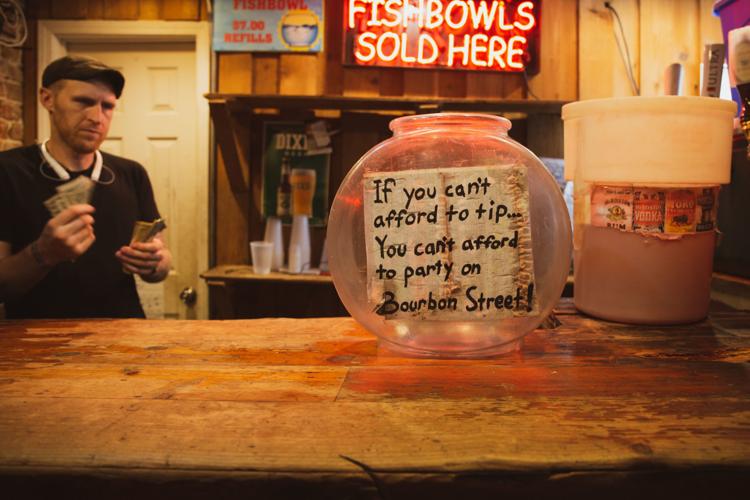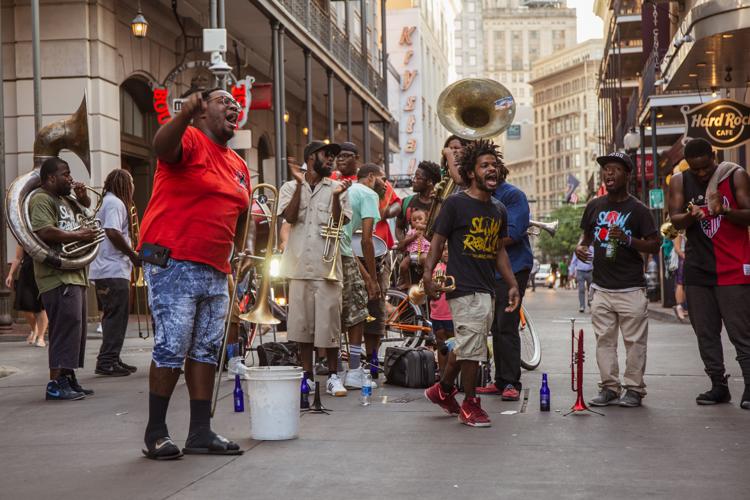There are countless Bourbon Streets.
There's residential Bourbon. There is gay Bourbon — whatever of its remains can be glimpsed beneath the screeching flocks of bachelorette vultures. There are subjective Bourbons: beggar's Bourbon, burlesque Bourbon, barker's Bourbon, busker's Bourbon. There is tender, poignant, instructively Hogarthian dawn Bourbon, morning Bourbon's busy trucks cleaning and restocking, the fetid siesta of afternoon Bourbon. There is the intriguingly liminal demographic overlap of dusk Bourbon, followed, of course, by evening Bourbon, night Bourbon and the unpredictable, paranoid but exhilaratingly raw Real Bourbon Hours Bourbon, where the lone stroller experiences relentless evaluation of their potential role in a binary of predator and prey.
It would be hard to do justice to any of these without outrageous generalization — one could go block by block, hour by hour, forever. There is, however, a coherent shorthand Bourbon of the collective imagination: Bourbon Street's upriver blocks, at night, lit by dream-like neon and crowded with revelers.
Those revelers overwhelmingly are tourists, which shapes Bourbon's reputation in the eyes of locals. Tourists can be frustrating, can ruin your life, kill your neighborhood and despoil your city like locusts, but one of the nice things about Bourbon Street is that spending time on it lets you be around tourists without having to hate them. They're having fun, they're spending money, and for once, they're where they belong. Bourbon is a specialized environment constructed expressly for them, shaped by decades of their desires and entrepreneurial trial-and-error into a smoothly running finance-extraction machine. In the ideal New Orleans tourist experience, the tourist at each stage of their visit — from airport to restaurant to hotel to bar — is given the privilege of contributing materially to the enrichment of their surroundings. Bourbon's where the gears mesh tightest.
Bourbon Street's recent repaving is nice and slippery, so the herds sluiced in from Canal Street can slide along slickly with minimal friction, slotting into the open doorways of the bars, clubs and restaurants for processing and value extraction. It's beautiful to see — beautiful the way watching birth is beautiful. Sure, a little messy at times, but it's such a natural, timeless process you can't help but feel moved.
Former Mayor Mitch Landrieu liked highfalutin committees that partnered with expensive consultancies to release ambitious, glossy plans. Celebrate Our History, Invest in Our Future: Reinvigorating Tourism in New Orleans, a 24-page report from the "New Orleans Strategic Hospitality Task Force," opens with a giant picture of a Bourbon Street crowd beneath its table of contents — and yet not once in all the report's sections, not in "Tourism: It's Our Future," or "Key Goals: More Younger Visitors; Brand as Authentic and Fun," not even in "The Master Plan: 13.7 Million Annual Visitors by 2018" is Bourbon Street mentioned or named.
"For hundreds of years," the report says, "New Orleans has been the gateway to Louisiana. New Orleans plays a major role in Louisiana's image, and it is a significant factor in potential visitors' decision to visit." It strikes me this could be as fairly said of Bourbon Street relative to New Orleans. "The French Quarter is New Orleans' most visited attraction," the task force tells us. OK, and what's the French Quarter's most visited attraction? The only clue is the page's bottom-most graphic, a jauntily-angled fragment of a "Rue Bourbon" street sign.
In his book Bourbon Street, journalist and geographer Richard Campanella’s comprehensive and thoroughly-researched history of the street, Campanella writes, "There is no Bourbon Street logo, no headquarters, no board of directors, no visitors' center, not even a website."
And yet what a juggernaut Bourbon Street is, generating millions of dollars year after year without focus groups, formal governance or expensive branding consultancies! It seems possible that, just as some of Louisiana's state-level leadership resents its most famous city, certain forces within New Orleans resent their city's most famous street. Perhaps the honchos of tourism hate Bourbon because they cannot own or control it; perhaps they fear the extent to which Bourbon Street's brand has blanketed New Orleans as a whole.
While Campanella's book is worthwhile and top of the reading list for anyone interested in Bourbon Street, those interested in the subjects of gender, race and economics may find Mr. Campanella's priorities don't mesh with their own. Campanella is preoccupied with whether modern-day Bourbon Street is "authentic" or "cool," designations he seeks to quantify via the sort of social-science methodologies whose chief and perhaps only virtue is their power to antagonize STEM nerds.
Cool is a Zen-riddle word functioning mostly as a cosmic floodgate for its own plentiful inverse. The older the participants debating something's "coolness," the wider gapes the cloaca through which pressurized uncoolness erupts. As regards authenticity, a term towards which Campanella evinces avuncular skepticism, I defer to another author, C.B. George, who calls authenticity "the child of that colonial pastime exotification ... sibling to the bigotry of essentialism."
So I shan't weigh in on whether Bourbon Street's authentic or cool — but I'll tell you it's beautiful. It looks like something from a video game, although no video game smells like this. No digital experience can bring you the heavy, damp air, redolent with pheromones, or the gauntlet of arctic blasts from open doorways that chill your sweat-soaked top against your nips.
Some on Bourbon Street are dressed as if for a glamorous photoshoot; some are barefoot and in rags; some are in rapid transition from the former to the latter. The crowd surges and swirls, teeming around you and then opening suddenly into sinister, unexpected lacunae of space and silence.
People of all ages are out, even after nightfall. You see pairs and clumps of the elderly, and even that most sacrosanct unit, the nuclear family: tense patriarchs grimly stewarding their variously bored or titillated wife-and-kids through the moral mire.
Because Bourbon Street is a place people come to from everywhere, seeking everything, supply-and-demand ensures everything is available — at a price, and at a risk. This infinite bazaar is presided over by countless cameras that may or may not work, bemused New Orleans police officers who may or may not work, and now the fanatical, fascistic state troopers who sullenly long to ticket everyone they see for jaywalking, open container and public intoxication.
There always have been at least a few good bars on Bourbon — and plenty of secrets. I hate to spoil any, but the correct passphrase (and for non-members, a cash payment) will induce the staff of a certain Bourbon Street establishment to escort you back through a "NO ACCESS" door to a fragrant stairway, from which you may ascend to a private vampire-themed speakeasy club with its own balcony and a high-priced menu of lurid signature cocktails. Can you find that on Frenchmen or Freret?
Bourbon has layers, like the rest of New Orleans. Ms. Rosie, whose bright blue hair and motley dress make her a recognizable French Quarter figure, has been collecting cans from individuals and businesses throughout the Quarter since 1995. She assures me there are more residents of Bourbon Street than one might think, even in the primarily commercial blocks close to Canal. "They're still there," she says, "upstairs. Maybe you don't see them ... some are very private. They've been there a long time."
NOLA.com arts-and-humanities stalwart Doug MacCash, who lived on Bourbon from 1978-84, described Bourbon Street as "the neighborhood bar of the whole region — the whole middle of the country." This feels true; Bourbon has a leveling, democratic quality. Few first-world communities have street life. For those who don't ride public transit and for most of their adulthoods travel via automobile between a few tightly curated situations — home, work, and whatever sad normie weekend rituals — Bourbon Street's sempiternal carnival gives them unmediated contact with all sorts of people they might not otherwise encounter. It's thrilling, and creates dense branching fractals of opportunity. You can feel it when you're around it: the vibrant pulse of possibility thumping within the heavy flesh of Bourbon's clamor.
I've developed a taste for walking Bourbon alone, but Bourbon with even one friend is a kick in the pants. Whatever you might think of what's happening around you, you're sure to be entertained by your friends' reactions, and on Bourbon, there's always something happening.
Bourbon Street is a social occasion. If you can't bring your own friends, you can make some — generous friends who will bankroll a rarified debauch, or false friends who will set you up for a mugging. In my experience, these friendships are ephemeral; I've never kept in touch with any of the visitors I've gotten to know on Bourbon, even when we were lucid enough to exchange phone numbers or make future plans. People are lonely and bored. They come to Bourbon Street wanting excitement, hoping to try something new. You can, without undue effort, be that for the night.
I think, even more so than the rest of New Orleans, Bourbon is to its visitors a backdrop. The twist is that those making Bourbon Street what it is are the tourists themselves. Some of my favorite parts of Campanella's book concern the history and development of this phenomenon, the evolution of Bourbon Street's street life into its main attraction. I think that's key to its beauty: a tourist spectacle where the tourists are the spectacle.
Not everyone who lives here likes Bourbon Street as much as I do. One friend, a New Orleans native who uses a pedicab to supplement her teacher's income, describes Bourbon as "a dirty tourist trap." When trawling Bourbon for customers, she says, "My catchphrase is 'Let me get you the hell off Bourbon Street.'"
I talked to Kat and Megan, a pair of 21-year-old twins undertaking a night out together on Bourbon. Kat, who lives elsewhere, never had been on Bourbon Street before; Megan, a senior at Tulane University, had been once or twice. Her introduction to Bourbon came the first Friday night of her freshman year: "My friends wanted to take me to Frenchmen Street, but they said, 'We have to make our Uber drive down Bourbon, so you can see how terrible it is.'"
It was, Megan said, "the trashiest place I'd ever seen." A few years later, her outlook has softened. "It can be fun. There's a time and a place for it — if it's someone's birthday, or you want to go out dancing and not pay a cover."
Many locals I talked to for this article described Bourbon as dirty, disgusting and gross. "We’d all be bankrupt without it," a club employee told me, "but there's probably a disease brewing in those rancid puddles that'll cause the zombie apocalypse."
I don't find Bourbon much dirtier than a lot of the places my friends like, but I sense in many of these critiques a disdain for the crowdedness of Bourbon; it can be very crowded. I wonder whether another element in the rejection of Bourbon Street might be that one can't feel possession of it: Bourbon's too huge, too open, too broadly popular to claim for oneself.
Back in 2009-10, I occasionally attended a Bourbon Street picket line outside the restaurant Tony Moran's. Trying to do any form of protest on Bourbon Street, unless you have big numbers or a big gimmick, is challenging. Nearly everything done on Bourbon becomes just seasoning for the larger Bourbon Street scene, subsumed into the pervasive sloppy silliness.
Notable exceptions were this year's historic BARE-organized rallies against the church-and-state-backed police harassment of exotic dancers, including a Bourbon Street protest that made international headlines for drowning out a press conference of city officials. The setting was key; the whole world understands Bourbon Street is a place for strippers, and the rallies functioned as reclamation, embarrassing the malefactors who'd been conspiring to deny dancers their livelihood.
Stripping, one of the best-paying entry-level jobs in New Orleans, has been associated with Bourbon for decades. A dancer who's worked all over the country told me, "In other places, people are ashamed to go to the strip club, but do it anyway because they hate their lives." This means the dancer has to mend the customer's gloom to get him in a celebratory spending mood. On Bourbon Street, by contrast, "You don’t have to try to cheer people up, because they’re already having a blast. On Bourbon, there’s nothing shameful about buying a lap dance ... it's part of the indulgent extravagance people come for."
Because New Orleans is a tourist economy, and because so many millions of tourists come to see Bourbon Street, Bourbon Street is important. We are lucky, then, to be graced with the best ambassador any street or city could hope for: Marie Francois, aka Mamie Marie, aka Silver Foxx, aka a few other things, the 71-year old street dancer who travels in a tricked-out tricycle with a big loud speaker system and a fringed canopy adorned with biblical admonitions.
Sometimes Mamie Marie plays her beloved "oldies-but-goodies" music, but when she's working, she plays Juvenile's "Back That Azz Up" on a loop, for an hour or more at a time, and dances energetically. People love it. On many weekends she is the center of a street party, ringed with other dancers inspired by her example and those filming the fun.
One video of Mamie Marie dancing has been viewed 11,000,000 times; by my reckoning, that makes her among New Orleans' most famous residents. She's got many other viral hits, which she collects on her Facebook: one video with 41,000 comments, another with 25,000. Mamie Marie's even in the opening of Beyonce's "Formation" tour video — and yet, in the egalitarian spirit of New Orleans, she's still working on Bourbon with the hoi polloi.
Mamie Marie came to New Orleans in 2012, and was homeless for five months. "I used to come out to Bourbon Street and hang out," she told me. "I didn't have any of this back then — but I got a boom box. I like my oldie-but-goodie music, and people would take pictures. They started tipping me, and then the next thing you know..." she gestured at her lit-up custom trike, bulging with a state-of-the-art sound system she controls from her phone.
While I interviewed Mamie Marie, she was continually approached by fans. "I had to come see you," one excited young woman told her. "I couldn't come to New Orleans and not get a picture with you."
To all these people, Mamie Marie, a Bourbon Street success story, is New Orleans. She is its smiling face, its exemplar, and the fun that people from around the world come here to seek. Bourbon Street is many things, including all the things its detractors don't like about it, but to me, Bourbon Street is the mythos with which visitors imbue it, the excitement it promises and the millions of dollars that change hands on that promise.
It's the place where Mamie Marie could show up with nothing but a joyful spirit and a boombox and make a living for herself.









